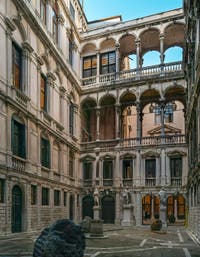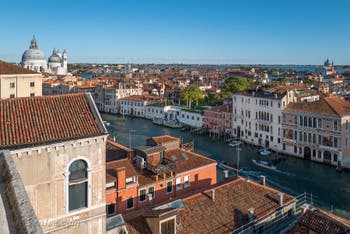Museums Doge's Palace | Guggenheim | Correr | Pesaro | Rezzonico | Murano | Accademia | Oriental | Ca d'Oro | Archeological | Querini | Bovolo | Pisani | Fortuny | Rocco | Lace | Marciana | Grassi | Dogana
Pisani Panoramic Terrace | History | Serlian windows | Leopold Robert | Napoleon
The Palazzo Pisani in Santo Stefano and its architecture
The facade on the Grand Canal
But there was still something missing from the Palazzo Pisani according to its owners: access onto the Grand Canal.It's true that the Palazzo Pisani already had several water gates opening onto the Rio del Santissimo (the river that runs beneath the choir of the Santo Stefano church) and which leads to the Grand Canal, but in terms of “prestige” this was undoubtedly not enough for the Pisani family.

The view of Venice's Grand Canal This is how the Pisani family managed to acquire a narrow strip of access to the Grand Canal in 1751 in order to build a new wing, linked to the rest of the buildings, and give a few extra letters of nobility to their palace, which still has its own semi-private campo, Campo Pisani, which is accessed from Campo Santo Stefano.
On the other hand, the narrowness of this façade at the corner of the Rio del Santissimo and the Grand Canal explains why only the upper floor has balconies, otherwise the narrow façade would have been “crushed”.
All this history of the successive construction of the different wings of the palazzo goes a long way towards explaining the very elongated shape of Palazzo Pisani, which is three times as long as it is wide.
Windows with “Serlian”
The façade of the Palace overlooking Campo Pisani has Serlian windows or Venetian Windows, which are one of the typical features of Venetian architecture of the period.A Serlian window is a composite window with three openings, two narrow, rectangular side bays and a wide, central, arched bay.

courtyard Pisani The Serlian, owes its name to Sebastiano Serlio (1475-1554), an architect originally from Bologna but who moved to Venice in 1527, and who illustrated the Serlian model in his work “Five Books of Architecture”.
This architectural treatise published in 1537 was considered a major work at the time.
Its publication in Venice had been greatly facilitated by the Aretin, of whom Sebastiano Serlio was also a friend, as he was also a friend of Titian
With Andrea Palladio, who made great use of it, the Serlian window became the “Palladian window” with the same principles: a large central opening with two small square windows on either side.
In the case of the Palazzo Pisani, yet another variant was used: sequences of two superimposed Serlienne windows.
Transformation into a music conservatory

The view of Venice's Grand Canal In 1897, Palazzo Pisani became the Municipal Music Conservatory of Venice, today known as the Benedetto Marcello Music Conservatory (Conservatorio Musicale Benedetto Marcello).
This new assignment has not diminished the prestige of Palazzo Pisani, far from it, since some of the greatest names in music have served as directors of the Conservatory.
These include Ermanno Wolf Ferrari (from 1903 to 1909), Gian Francesco Malipiero (from 1940 to 1952) and Marco Lucio Bossi. The Benedetto Marcello Conservatory also had famous pupils such as Luigi Nono and Bruno Maderna. The large ballroom of the Palazzo Pisani is now used as a concert hall. It boasts its own organ, built in 1898 by the firm Vegezzi Bozzi. It was restored in 1959
Pisani Panoramic Terrace | History | Serlian windows | Leopold Robert | Napoleon
Museums Doge's Palace | Guggenheim | Correr | Pesaro | Rezzonico | Murano | Accademia | Oriental | Ca d'Oro | Archeological | Querini | Bovolo | Pisani | Fortuny | Rocco | Lace | Marciana | Grassi | Dogana
Back to Top of Page

